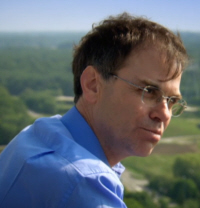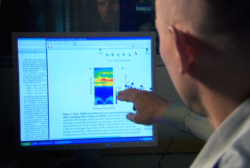Fundamental Particles
spinons, orbitons & holons
Horizon - small Universe
Particle Explosion
Some of the earliest machines used to probe the atom were bubble chambers, that produced exquisite pictures of the heart of matter.
And now, behind these doors, Joachim Mayer has a machine that gives us the best possible view.
Andy Parker "What you see here is a sudden explosion of particles from nowhere in the liquid of the bubble chamber and that
is because a neutrino has hit an atomic nucleus there and smashed it to pieces, and we see the particles flying off. And that's anti-matter being created
from pure energy. So this is the map or a part of the map, of what nature can do. So it's part of the map of the universe."
But now, after 80 years of smashing, the map is complete. In the summer of 2012 scientists at the LHC, announced the discovery of the famous Higgs
particle. It's the final piece of what's called the Standard Model – a set of 17 fundamental particles including quarks and electrons that make up
everything we know.
But for physicists like Andy it's not the end of the story.
Andy Parker "Everyone's heard about the Higgs but the story goes much beyond that. In fact my main interest is beyond the Higgs.
Like any great explorer, Andy is not satisfied that this is the end of the journey.
ATLAS Control Room
Andy Parker "OK so we're in the ATLAS main control room, this is where the experiment crew, shift crew here are sitting taking data today.
Collisions are happening 40 million times every second."
And as the energy of the collisions increases, Andy will be able to look on smaller and smaller scales, even delving inside the so-called
fundamental particles.

Andy Parker
Andy Parker "Fundamental particles is a myth, I think. It looks at the moment as if quarks and electrons are point-like particles. We can't see any
size to them but that is just because we haven't been able to measure very short distances around them. What I'd like to see this what's going on inside
them. So we're looking for the innards of the quarks by smashing them together as hard as we can."
In the search for the smallest piece of the universe, part of the problem may be knowing when to stop. Each new layer reveals great secrets.
But does this search have an end?
Or within every small thing, is there another… and another?
Perhaps the best known of all the fundamental particles is the electron. It underpins much of our modern lives, from computers to streetlights
to televisions. But for theoretical physicist Professor Jeroen van den Brink, the electron might not be as fundamental as we think.
Jeroen van den Brink
Professor Jeroen van den Brink "The more fundamental things are, the nicer it is to look inside them. Physics it's always that something appears
to be fundamental, and just because we believe it is fundamental we take the next step and try to look what's inside it."
Jeroen's idea was that, rather than smashing electrons into pieces, he could find a different way to split its properties… the very properties
that make it so useful.
Jeroen van den Brink "So the electron has three fundamental properties, charge, spin and orbital and theoretically it's definitely possible
to split those three parts of the electron. If you do the mathematics there is no problem in doing that. If you do the quantum mechanics, it's
completely allowed. So in principle you can split the electron, at least you can do it on paper."
Swiss Light Source
If you want to do it in practice, you need this… the Swiss Light Source, a million watt light bulb.
Andreas Ludeke "This is an in vacuum undulator."
The Swiss Light Source is in fact the Swiss X-ray Source. Inside the ring, under the care of Dr Andreas Ludeke, a beam of electrons creates the
ultimate x-ray laser.
Andreas Ludeke "This is a superconducting cavity."
It's one of the most powerful, highly focused, narrow x-ray beams in the world.
Andreas Ludeke "We have a high intense magnetic field in the middle."
Dr Thorsten Schmitt
The perfect tool for probing down to the size of an electron. Jeroen's partner in electron splitting, the man he devised and runs the experiment,
is Dr Thorsten Schmitt of the Paul Scherrer Institute.
Dr Thorsten Schmitt "So here we are in the so-called optical hutch, where all the crucial optical elements – mirrors which are optimised for x-rays
and which are used for shaping the beam quality are sitting."
Jeroen van den Brink "So when I come here I go to the equipment, I look at it, I admire it and then I go back and sit behind a computer or take
my pen and paper and start to do the mathematics. I do not really understand what the stuff out here is exactly doing and I believe, I'm sure Thorsten
does and they do the experiments."
Thorsten Schmitt "We have x-rays, which are coming in and hit a sample, and we will then in the end analyse the x-rays, which are re-emitted or
scattered off from the sample."
When the x-ray beam strikes, the electron split into new quasi-particles. These particles, called spinons, orbitons and holons, carry the
properties of the electron, and can travel off in different directions.
Jeroen van den Brink "this is actually the picture that tells the whole story. The most important part is here, the red part, what's important is
that it's wavy. And this waviness tells us that what happened in this experiment is that the electron was split into spinons and orbitons. So
this is the picture that is the experimental proof that the electron has been split. So the electron can be split into these three different
particles, but, really, what can you do with those particles when you have them? I don't have a good answer to that."
The electron has, in one sense, been split in three. But it's a measure of just how weird things are doen here that it still considered
to be fundamental. Down at this scale, we just have to accept that the rules become deeply strange. And if we reach down even further, we may
have to throw out the rule book altogether.

